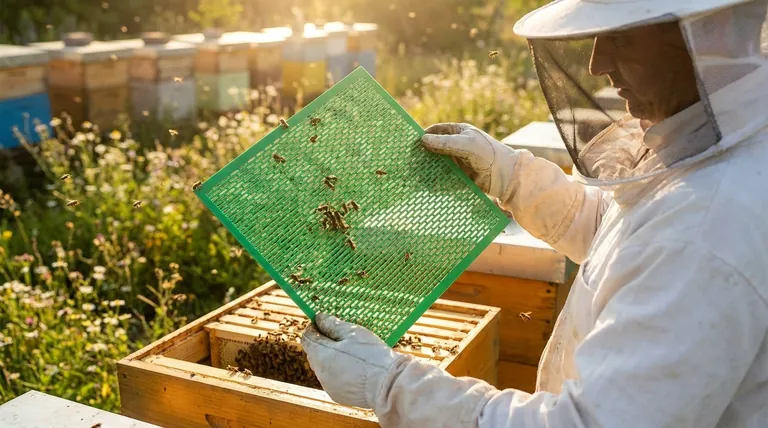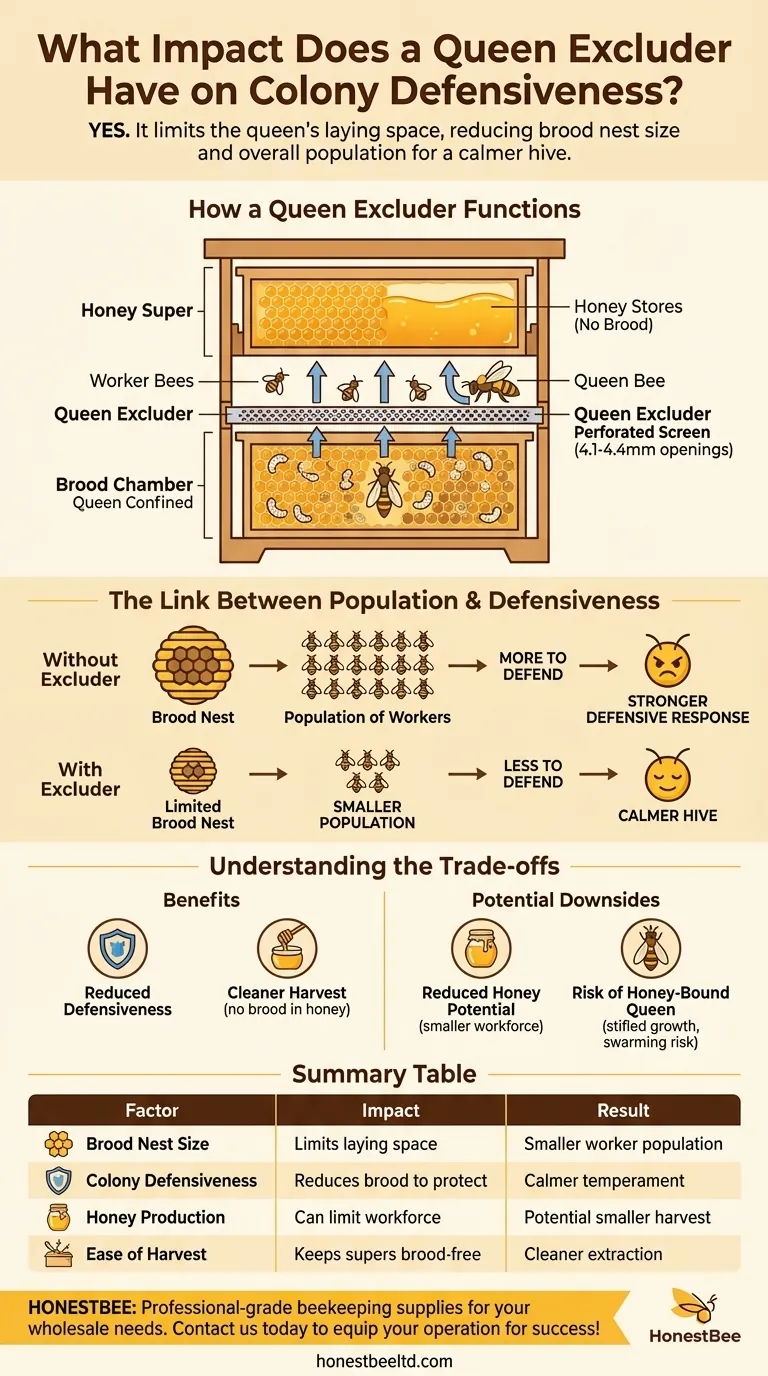In short, yes. A queen excluder can reduce a colony's overall defensiveness by limiting the queen's laying space. This restriction controls the size of the brood nest, which in turn limits the total population of worker bees. A smaller, less populous colony is generally less defensive than a massive one.
The defensiveness of a honey bee colony is directly linked to its population size and the amount of brood it needs to protect. A queen excluder is a management tool that gives a beekeeper indirect control over colony temperament by placing a ceiling on its population growth.
How a Queen Excluder Functions
A Simple Matter of Size
A queen excluder is a perforated screen placed between the brood boxes and the honey supers. The openings, typically between 4.1 and 4.4 millimeters, are large enough for worker bees to pass through but too small for the queen's larger thorax.
This simple physical barrier effectively separates the hive into two distinct zones.
Separating the Brood Nest from Honey Stores
The primary function of the excluder is to confine the queen to the lower brood chamber. By preventing her from accessing the upper boxes (honey supers), you ensure she only lays eggs in the designated area.
This guarantees that the honey supers contain only honey, making the harvest process much cleaner and simpler, as there is no risk of finding eggs, larvae, or pupae mixed in with the honeycomb.
The Link Between Population and Defensiveness
The Brood-to-Defensiveness Connection
A bee colony's most vital instinct is to protect its young—the brood. A larger brood nest means there is more to defend, which often triggers a stronger, more immediate defensive response from the worker bees when the hive is disturbed.
How Excluders Limit Population Growth
By confining the queen to a set number of frames in the brood chamber, you artificially limit the number of eggs she can lay. This creates a hard ceiling on the amount of brood the colony can raise at any given time.
Fewer eggs mature into fewer adult worker bees, effectively controlling the colony's maximum population.
A Smaller Population Means a Calmer Hive
A colony with a smaller population has fewer guard bees and a less overwhelming defensive response. This effect is particularly valuable in regions with Africanized honey bees, which are known for their high defensiveness and rapid population booms.
Using an excluder is a standard technique to help manage the temperament of these "hot" hives, making them safer to work with.
Understanding the Trade-offs
Reduced Population Can Mean Less Honey
The most significant downside is that a smaller workforce can translate to a smaller honey harvest. A massive population of foragers is what brings in a bumper crop of nectar.
By limiting the population to manage defensiveness, you may also be limiting the hive's honey production potential.
Risk of a "Honey-Bound" Queen
In a strong nectar flow, workers may begin storing nectar in the brood chamber because they are filling the supers above. If the queen is confined by an excluder, this can reduce her available laying space even further.
A "honey-bound" brood nest can stifle population growth more than intended and may increase the colony's instinct to swarm.
Making the Right Choice for Your Goal
Ultimately, the decision to use a queen excluder depends on your specific beekeeping objectives.
- If your primary focus is managing defensiveness: Using an excluder is a reliable method for limiting population size and keeping a colony's temperament predictable and calm.
- If your primary focus is maximizing honey production: You may opt to go without an excluder to encourage the largest possible workforce, but you must be prepared to manage a larger and potentially more defensive colony.
- If your primary focus is ease of harvest: The excluder is an invaluable tool for ensuring your honey supers are completely free of brood.
By understanding how this simple piece of equipment influences bee biology, you can manage your hives with greater precision and confidence.

Summary Table:
| Factor | Impact of Queen Excluder | Result |
|---|---|---|
| Brood Nest Size | Limits the queen's laying space | Smaller population of worker bees |
| Colony Defensiveness | Reduces the amount of brood to protect | Calmer, less defensive hive temperament |
| Honey Production | Can limit the size of the foraging workforce | Potential trade-off for a smaller honey harvest |
| Ease of Harvest | Keeps honey supers free of brood | Cleaner, simpler honey extraction process |
Manage your apiary with confidence and precision. A queen excluder is just one tool in a comprehensive beekeeping strategy. For commercial apiaries and distributors, having access to high-quality, durable equipment is essential for effective hive management and productivity.
HONESTBEE supplies professional-grade beekeeping supplies and equipment through wholesale-focused operations. Let us help you equip your operation for success.
Contact HONESTBEE today to discuss your wholesale needs and discover how our reliable equipment can support your beekeeping goals.
Visual Guide

Related Products
- High Performance Plastic Queen Excluder for Beekeeping and Apiary Management
- Professional Plastic Queen Excluder for Modern Beekeeping
- Premium Wood Framed Metal Wire Queen Bee Excluder
- Wooden Queen Bee Excluder for Beekeeping
- Plastic Queen Bee Excluder for Bee Hive Wholesale
People Also Ask
- When is the best time to place a queen excluder? Optimize Honey Production & Purity
- What materials are modern queen excluders made from? Choose the Right Material for Your Apiary
- When should I remove my queen excluder? Timing is Critical for Winter Bee Survival
- What are the benefits of a queen excluder? Ensure Pure Honey & Simplify Hive Management
- What is a queen excluder, and how does it function? A Guide to Hive Management



















